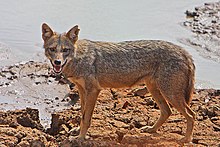| Jackal | |
|---|---|

| |
| Golden jackal (Canis aureus) | |
| Scientific classification | |
| Domain: | Eukaryota |
| Kingdom: | Animalia |
| Phylum: | Chordata |
| Class: | Mammalia |
| Order: | Carnivora |
| Family: | Canidae |
| Subfamily: | Caninae |
| Tribe: | Canini |
| Subtribe: | Canina |
| Species referred to as jackals | |

| |
Jackals are canids native to Africa and Eurasia. While the word "jackal" has historically been used for many canines of the subtribe canina, in modern use it most commonly refers to three species: the closely related black-backed jackal (Lupulella mesomelas) and side-striped jackal (Lupulella adusta) of Central and Southern Africa, and the golden jackal (Canis aureus) of south-central Europe and Asia. The African golden wolf (Canis lupaster) was also formerly considered a jackal.
While they do not form a monophyletic clade, all jackals are opportunistic omnivores, predators of small to medium-sized animals and proficient scavengers. Their long legs and curved canine teeth are adapted for hunting small mammals, birds, and reptiles, and their large feet and fused leg bones give them a physique well-suited for long-distance running, capable of maintaining speeds of 16 km/h (10 mph) for extended periods of time. Jackals are crepuscular, most active at dawn and dusk.
Their most common social unit is a monogamous pair, which defends its territory from other pairs by vigorously chasing intruders and marking landmarks around the territory with their urine and feces. The territory may be large enough to hold some young adults, which stay with their parents until they establish their own territories. Jackals may occasionally assemble in small packs, for example, to scavenge a carcass, but they normally hunt either alone or in pairs.